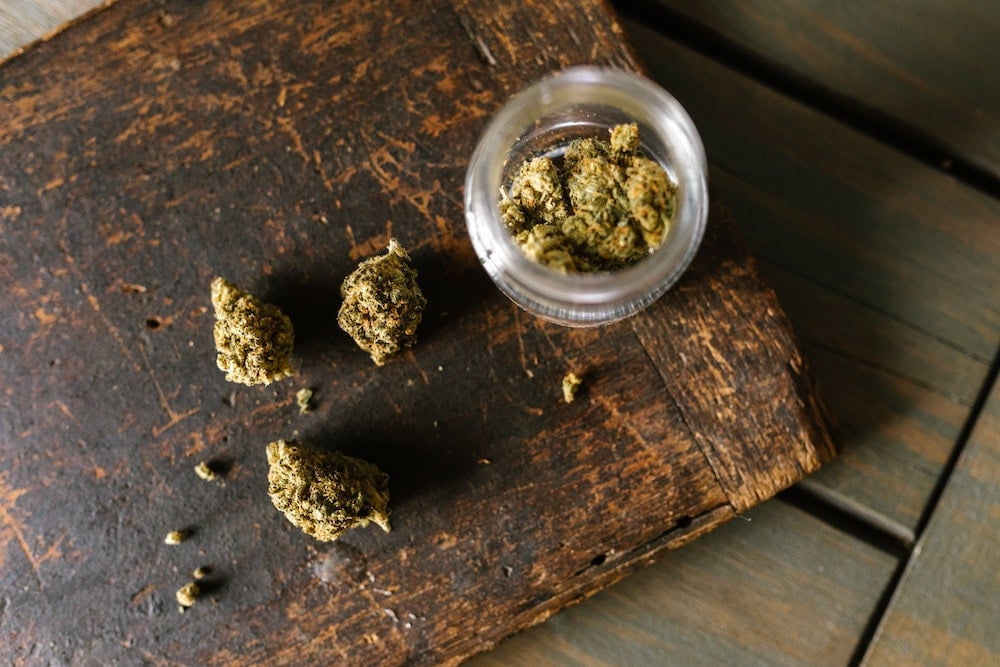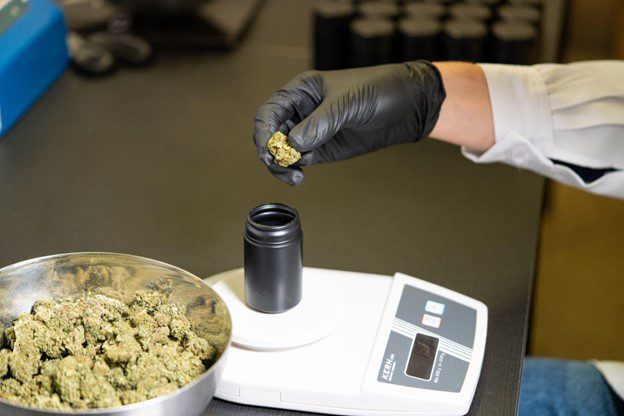
What Is Cannabis Decarboxylation & Why Do You Need to Do It?
Have you ever wondered why you need to smoke weed to get high? Yet, you could eat a pound of raw cannabis flower and still not feel the euphoric buzz of THC. The reason: THC does not exist in raw marijuana without cannabis decarboxylation.
Cannabis decarboxylation is the key chemical process that creates the THC and CBD you know and love. These cannabinoids exist in a form your body simply cannot process. They naturally exist in the cannabis plant as acids that don’t provide the high of THC or the health benefits of CBD.
Heating these acids converts them into a form your body can use. Otherwise, THC exists as tetrahydrocannabinolic acid (THC-A) and CBD as Cannabidiolic acid (CBD-A). There are also other common cannabinoids like CBG, CBC, and THCV that all exist as acids in the plant.
While THC-A is an antioxidant that can offer you a few healthy boosts, it will not get you high. CBD is growing in popularity as a treatment for many conditions, but the human body cannot utilize CBD-A, so the body will mostly eliminate it.
Consuming these cannabinoids in their acid form can waste perfectly good THC and CBD. Cannabis decarboxylation is a must to get the most out of your cannabis.
What Is Cannabis Decarboxylation?
Decarboxylation is simply the chemical term for eliminating a carboxyl group. If you remember from chemistry class, the carboxyl group (COOH) is one carbon atom attached to an oxygen atom and an oxygen and hydrogen molecule. This is done through heat and light.
Often found in amino acids, there’s a carboxyl group in both THC-A and CBD-A. When smoking or vaping, you instantly remove these carboxyl groups by decarboxylating the THC-A and CBD-A with the heat from your flame, vape, or smoking apparatus.
When heated to a certain point, the carboxyl group will get released as carbon dioxide (CO2). This will leave you with a psychoactive THC and beneficial CBD that your body can process.
When smoking, you instantly inhale the newly created THC and CBD.
Decarboxylating, or decarbing, can happen naturally over a longer period. For example, you may notice that your weed can naturally turn brown over time. That’s decarbing. This happens instantly when smoking due to the heat.
Natural decarboxylation could take years. Cannabis can also slightly decarb when exposed to heat during the drying or curing process. This means that some of the THC-A can become THC. However, the goal of cannabis decarboxylation is to convert these cannabinoids to make edibles.

Photo by CRYSTALWEED cannabis on Unsplash
Why Is Cannabis Decarboxylation Important?
Decarboxylation, or decarbing, is important to harvest cannabinoids. However, getting high from THC isn’t the only benefit of consuming cannabis. As CBD is becoming more sought as a treatment for insomnia, chronic pain, and anxiety, the CBD-A in raw cannabis is not bioavailable.
The endocannabinoid system is the part of the human nervous system that interacts with the terpenes and cannabinoids in cannabis. Without decarbing cannabis, your body will simply discard the CBD-A. Plus, it will not provide the buzz of THC.
THC and CBD can directly interact with your endocannabinoid system when not in their acid form. So if you plan to use cannabis for edibles, decarbing is vital. It not only helps make these cannabinoids available, but it can also ensure there’s no mold or fungus.
Decarbing involves heating the flower at over 200ºF for a while. The sweet spot is around 30-40 minutes. This can ensure there aren’t creepy crawlies in your cannabis. By heating your cannabis for a prolonged period, you ensure there’s the CBD and THC you want and nothing you do not.
How Do You Decarboxylate Cannabis?
The key to decarboxylating cannabis is low and slow. Heating it slowly over a longer time ensures you decarboxylate the THC-A, CBD-A, and other acids without burning off any of the terpenes. The last thing you want is a burned or turned taste when making edibles.
Decarboxylation Temperatures
More heat does not mean better or faster results. While most marijuana compounds decarb at around 240ºF (115ºC), there is no established threshold for all THC and cannabinoids to cross over from acid state to “active” state. Some compounds have lower decarbing points than others, and for you to enjoy their benefits and make edibles, you need to master the art of heating.
Most experts agree that 230-250°F is the ideal temperature range to decarb cannabis – THCA becomes THC while preserving the terpenes and cannabinoids. Here is a quick rundown of the average temperatures you need to keep an eye on when trying decarboxylation at home.
- THCA converts into THC at 230ºF (110ºC) if you leave it in the oven for about 30 minutes
- CBDA converts into CBD at 230ºF (110ºC) if you cook it for about 40 minutes. You can get results in 20 minutes if you heat it at 265ºF (130ºC). Some agree that CBD decarboxylation should be done at slightly lower temperatures than those for THC.
- Terpenes – experts agree their decarboxylation temperature is in the range of 200ºF – 290ºF (95-145ºC). However, some have boiling points a couple of degrees above their decarb temp, so you need to be very careful.
Don’t exclude some trial and error from your practice. Like in high-end baking, you must master your skills and learn how your oven works in the tiniest detail.
Decarboxylation Methods
There are a few different methods for decarboxylating. Decarboxylators are machines that automatically heat your cannabis to the desired temperature. That being said, you do not necessarily need an expensive machine and can easily do it at home using your oven.
Other options include using the sous vide process, where you place the cannabis in a heat-safe bag and then boil that bag for the desired effect.
How Do You Decarboxylate Cannabis in an Oven?
The most uncomplicated process is to use your oven. All you’ll need is a tray and a bit of parchment paper. Here’s how to easily decarboxylate cannabis at home:
- Start by preheating your oven to 220ºF.
- Line an oven-safe tray or pan with parchment paper.
- Break up the cannabis or grind it so it can lay it evenly on the pan.
- Place in the oven for about 30 minutes.
- Remove from the oven and allow it to cool.
Note: Decarbing at home can make for an intense weed smell. Using an oven-safe bag, the sous vide process, or a mason jar can help decrease the smell.
If you’d like to use a mason jar, be careful as they can become pressurized, and not all mason jars are fit for oven use.
Also, be sure to use parchment, not wax paper, as wax paper can damage your cannabis when exposed to heat.
After cannabis decarboxylation, you can use your cannabis to make canna oil, cannabutter, or other edibles, or simply store it for later. Be sure to store it in an airtight container and keep it in a cool, dark place.
Apply for a Medical Marijuana Card Online Today
Join over 100,000 patients who have chosen Green Health Docs as their medical cannabis doctors. We have a 99% approval rate and offer a 100% money back guarantee!
How Long Can You Keep Decarbed Cannabis?
You should try to use your cannabis soon after decarbing to ensure you can cultivate the most cannabinoids. Decarbed weed will keep for about six months before the THC can start to oxidize and convert into the more sedative CBN.
Should You Use a Grinder Before Decarbing?
Grinding up your cannabis will increase the surface area. However, if you grind it up too finely, this can encourage burning. You’ll want to ensure that you grind it up enough so that you can create an even layer of cannabis on your baking sheet.
This will help you ensure even cannabis decarboxylation and avoid burning. If you ever smell burning, be sure to lower the heat to ensure that you don’t overcook your cannabis and burn away any of the valuable cannabinoids or terpenes.
Can You Decarb In The Microwave?
Remember, the key is low and slow. The heat from a microwave is too unreliable, and you are more likely to burn away your cannabinoids than effectively decarb them. Likewise, using a microwave or a higher heat in your oven will not speed up the process.
If you’re looking to save time or prep, you can use a toaster oven as long as it can reliably reach 220ºF.
Can You Smoke Decarboxylated Weed?
Once you’ve decarboxylated your cannabis, you can potentially smoke it. However, you will find it does not have the same effect as fresher cannabis. This is because you have transformed most THC and CBD from their acid forms.
You’re more likely to burn actual THC and CBD, which can burn off in the high heat. So while you can technically smoke it, you’re less likely to receive the health or recreational benefits you’d get from traditional cannabis.
Does THC-A Have Any Benefits?
While the body cannot process CBD-A, THC-A does have some health benefits. For example, one study has shown that THC-A can help inhibit prostaglandin production, which reduces inflammation.
Studies have also proven that THC-A can help reduce liver inflammation and nausea, having neuroprotective properties in lab animals. As a result, more people are using raw cannabis either in juices, smoothies, or by adding it to salads to harvest some of these THC-A benefits.
Depending on how you consume cannabis, whether by smoking, in edibles, or even in its raw form, you will be exposed to a different medley of terpenes and cannabinoids. As cannabis consumption grows, more studies will reveal how these different compounds affect the body.
Cannabis Decarboxylation: Quick Summary
- What is decarboxylation: the process of heating marijuana at specific temperatures to obtain activated THC and CBD from THC-A and CBD-A, respectively.
- You decarb marijuana when you smoke it or vape it.
- Decarboxylation is the answer if you wonder how to make weed butter or edibles in general.
- You can decarb cannabis at home using a regular oven (use a baking sheet or even a mason jar), in a microwave oven (you need to be very careful with the timing and temperatures), or in a decarb machine.
Final Thoughts
Many seek out cannabis for the high, others for the medicinal properties of CBD. However, heat in some form is required to harvest the beneficial cannabinoids to ensure your body can actually use them.
Smoking may not be ideal, especially for those seeking medicinal marijuana; the solution is to ensure proper cannabis decarboxylation before making any edibles or infusions and ensure that you have more available cannabinoids to get the most bang for your medicinal buck.
This article is reviewed by Dr. Anand Dugar, an anesthesiologist and pain medicine physician. He is also the founder of Green Health Docs. Graduating from medical school in 2004 and residency in 2008, Dr. Dugar has been a licensed physician for almost 20 years and has been leading the push for medical cannabis nationwide.
